Anatomical Studies of a Male Shoulder
Anatomical analysis in Leonardo da Vinci’s view, served a grand purpose for it made it possible to rediscover the outlining mechanics that correspond to movement and emotion, which can further be exemplified as exact images detailing the muscular movements of the body in grand proportions working together as one. Their presentation, however, served purpose in an intuitive sense of perception, as well as, a feeling of proper balance, aspects of which Leonardo seems to value most above all else. Leonardo’s anatomical illustrations and drawings though of the renaissance era meticulously match that of modern science, and yet he used no brilliant mechanical/ technological marvel to achieve this feat, the title ‘Renaissance Man’ surely is deserving of his illustrious wits and advances in pushing forth the Renaissance epoch. Leonardo da Vinci’s anatomical illustrations were so precise and absolute that many till to date are used to illustrate medical textbooks. Every image in each of Leonardo’s sheets is similarly animated by the alacrity of Leonardo’s thoughts as each one of them jostles and teams with observations, ideas, and reflections a bit like the fossilized remains of someone’s synapses firing on all cylinders half a millennium ago. Throughout his life works observation can be drawn that there is much correspondence between his mechanical drawings and the anatomical studies, this is drawn from the fact that Leonardo viewed the human body as the most-perfect machine. Initially, Anatomy was a way for Leonardo to make his paintings of the human body more effective, to start with, his knowledge wasn’t based on first-hand observation but on speculative classical literature stretching back to Galen and Aristotle, this meant that some of his drawings weren’t always correct. But his inquiring mind asked questions about the human form that had never been asked before. The breakthrough finally came at the fall of the decade when Leonardo inscribed the head of a page in a new notebook on the second day of April 1489, on the book entitled on human figures. And in the pages that followed, Leonardo executed exquisite series of drawings of the human skull all meticulous, lucid, and very precise, clearly made from first-hand observation. Finally after having greater access to human material, gave Leonardo an enhanced understanding of anatomical structures lending his drawings scientific credibility, but of course, it wasn’t just about observation for Leonardo, for he was also an excellent draftsman. Leonardo writes that a painter who has acquired the knowledge of the nature of the articulacy and actuality of the sinews, muscles, and tendons. Knows exactly in the movement of any limb of the body, how many and which of the sinews in the collective make up are the cause of it, and which muscle by its bulging/ swelling is the cause of this sinew’s contracting. We tend to think of Leonardo Da Vinci as a painter, but for the majority of his life he was also a scientist designing robots, studying the properties of water, endeavouring to understand the secrets of flight; but the scientific field in which he most excelled was that of Human Anatomy. Leonardo first started to research the human body to help him keep his paintings as true to nature as possible, but the project soon took on a life of its own, and he filled hundreds of his notebooks with detailed sketches. Leonardo’s aim was always to publish an illustrated treatise on the human body, but tragically he never did. There can be no other scientist whose work was profoundly insightful as Leonardo’s was, that has sorrowfully had so little impact on his chosen field. But the greatest perception in Leonardo’s entirety was that the noblest of pleasures is birth from the joy understanding. Throughout his career in Anatomical Studies, Leonardo is said to have dissected bodies by the candlelight; drafting outlines with a piece of cloth sheathing his nose and mouth, a world away from the all too comfortable surroundings largely associated with his portrait illustrations. Leonardo is accredited as the first intellect to fully draw three-dimensional illustrations of dissected body parts, as well as, accurate conception in illustration of the child in the womb; one of the few sheets in which Leonardo uses color. The red chalk leaps out of the canvas, and that red, or rather the startling use of red, goes forth in giving the fetus a sense of life, all too ravishing, heart-stopping, and captivating to say the least, a feature that is possibly lacking in other sheets. History dictates that Leonardo da Vinci aimed to record the birth, life, and death of a man, in his prevalent treatise on Anatomy that is said to have begun in 1489.


